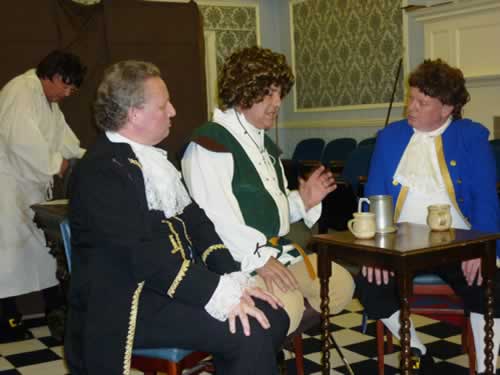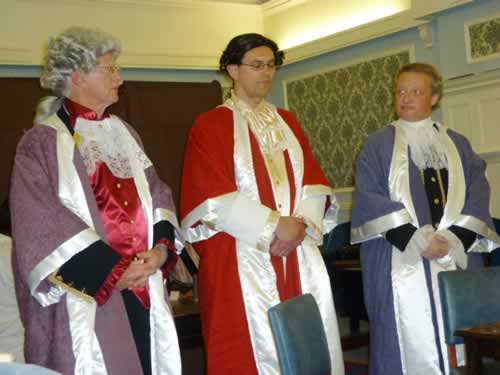An Introduction by the Most Excellent Grand Superintendent, EComp Wayne Williams
We often speculate that the origins of Craft Masonry particularly are lost in the mists of time but that probably most of that which we recognise as Craft Masonry today stems from the lodges of Operative Masons, so prevalent in medieval England and western Europe, and renowned for their magnificent edifices and accomplishments. But what of the Royal Arch?
The beginnings of the Order are much better documented from the mid-eighteenth century onwards but it did occur to me in a rare moment of reflection some two/three years ago that perhaps not too many Companions, particularly our younger members, would really appreciate the traumas and the frustrations encountered by the Royal Arch in its early formative years from the mid-1750s onwards. It makes fascinating reading.
I could not previously recall any formal or approved way of relating the history of the Royal Arch in our Chapters; no serious questions had been raised as far as I was aware and it appeared an unknown subject which had generated very little interest. How best therefore to raise the profile of the Royal Arch by enlightening both Brethren and Companions of those early difficult years in an interesting and informative way?
Giving this some serious thought, it was around this time that the Provincial Demonstration Team had so successfully launched its Craft re-enactment, 1759, and then only to find that the Royal Arch and its origins was already the subject of some detailed research by EComps Bill Purcell and Barry Weigleb.
Even better – their thoughts had already turned to the possibilities of a Royal Arch re-enactment to highlight, both for Craft Lodges and Royal Arch Chapters, the uncertainties and dubious acceptability of the Order where it had been totally embraced by theTraditioners, and even adopted as a fourth Degree in their Craft workings and where, for all intents and purposes, any question of the Royal Arch had been completely rejected as an unnecessary imposition by the so called Modernisers.
Discussions then followed with EComps Purcell and Weigleb together with EComp Trevor Sherman; I was fortunate enough to have been included in their various briefings and their proposals. Following an exploratory trip to the Province of Devonshire to see their Royal Arch re-enactment team in action in a Chapter meeting in Dawlish in January of 2009, it was clear to me that we had the nucleus of an idea which, over subsequent months, was to blossom into the first performance of HOW and WHY the ROYAL ARCH, so professionally presented at the April meeting of First Principals’ Chapter in Northampton. This was in the presence of representatives from neighbouring Provinces of Leicestershire & Rutland, Warwickshire and Bedfordshire, all of whom had previously registered an interest in our initiative.
The performance was, I think, greeted with much acclaim and appreciation – an unusual development for a normally rather conservative Royal Arch but a great credit to those Companions already mentioned for all their hard work in researching, scripting and directing, to those who performed so magnificently with such good humour whilst at the same time delivering the message, and to the Province of Northamptonshire & Huntingdonshire for leading the way again with so much support so generously given by the Provincial Grand Master and his Executive. I thank them all.
The Premiere
The Provincial Demo Group presented their premiere of HOW and WHY the ROYAL ARCH to a packed house of members and guests at the Installed First Principals Chapter No 3422 on St Georges Day, Friday 23rd April 2010. The Most Excellent Grand Superintendent, EComp Wayne Williams attended with his his equivalent from Leicestershire & Rutland, EComp Peter Kinder and the Provincial Grand Master, RWBro Barrie Hall.
Through the eyes of a cheeky potman (played by Steve Squires) working in the Inn where a number of Lodges meet, the audience is introduced to a scene around 1740 when a rift was opening between the so called Traditioners and Modernisers. They have opposing views on the ritual and workings of the degrees.
We find a newly installed Worshipful (played by Simon Harker) frustrated at not discovering the genuine secrets and being cautioned by a Past Master (played by Trevor Cooke) to accept things as they are. Enter Lawrence Dermott from Ireland (played by Owen Davison) to introduce the ‘Fourth Degree’ as a solution for our frustrated Worshipful and berate the Modernisers for tampering with the ceremonies. Dermott confides that whereas the Craft deals with our worldly existence, the fourth degree, or Royal Arch, is the re-awakening of our spiritual existence.

The three Principals (played by Peter Ayton, Dale Gilbert & Trevor Cook) dressed in their resplendent robes to reinforce the vivid colours of the Royal Arch, provide a brief introduction and resume of the demonstration and link this glimpse of our history with the Royal Arch we know today. They conclude that the legend of the Royal Arch deals with man’s most private and personal emotions, his relationship with his God, his Supreme Being, and his hopes for a life hereafter.

The Demo Group gives us a single play that meets the needs of Chapters and Lodges. It brings the subject to life in a way that will make a Master Mason think more about the past and want to join the Royal Arch for the ‘right’ reasons. It also gives Companions at all levels of experience, an opportunity to reflect on the object and origins of the order. It has humour and drama and it is thought provoking. The Demo Group hope it will stimulate the search for more knowledge and constructive frustration that there is always more to know and more to discover.
The Most Excellent Grand Superintendent of Leicestershire & Rutland, EComp Peter Kinder, said
The play was well written; not too deep, but informative enough to get the message across, especially to those with an enquiring mind. The acting was of high quality and well performed. I especially enjoyed the role of Potman. The humour he bought to the play was a vital ingredient to the atmosphere of the period, I also felt that he held the play together, almost in a sort of narrator role. I thought one of the key parts of the play was the influence of Lawrence Dermott. He, as we know, was the Freemason who coined the phrase that the Royal Arch Degree is theRoot, Heart & Marrow of Masonry and he was so much the founding influence of the Royal Arch.
The Provincial Grand Master, RWBro Barrie Hall, said
This presentation proved a most enjoyable and enlightening insight into the origins and development of the Royal Arch within Pure Ancient Masonry. My congratulations to EComps Bill Purcell and Barrie Weigleb on a well researched and expertly written playlet, and to the members of the Provincial Demonstration Team who presented with considerable panache and effect. My best wishes for future presentations of this key aspect of our masonic journey. I have no doubt they will be received with considerable acclaim and enjoyment and with an awareness that we shall all certainly be making several fascinating daily advancements in masonic knowledge.
This one play is suitable for both Craft (MM only) or Chapter audiences. A spin off from this play are two talks that are given by the authors - one to Chapters and one to Craft Lodges - entitled ‘HOW and WHY the Royal Arch - The Journey’. The play and the talk can be combined on a single evening to an event that runs for about 60 minutes.
